The 'Enigma' Variations, written in 1899, and first performed on 19th June of that year, turned Elgar from a provincial musician into the makings of an international composer.
The previous year, tired after a heavy day's teaching at a local girls' school, Elgar was relaxing and improvising at the piano. He would probably have continued in his daydream and the piece would have been lost to posterity had his wife not remarked suddenly "What was that?". Elgar replied, "Nothing. But something might be made of it!". He then improvised a few impromptu 'variations' in a way as to suggest the mannerisms of a few of their friends - a characteristic laugh, a slight stammer, an attempt to play the piano, a way of moving around a room and leaving with a slam of the door.
And so the 'Enigma' Variations were created. But what is the enigma? That is a mystery which has endured for almost a hundred years.
The obvious answer was the identity of the friends of the Elgar's which he had characterised in the music - but this would only be relevant to those who were acquainted with those people (and even the 'variationees' themselves were unlikely to know personally all of their colleagues!). In fact, the dedication of the work is to 'My Friends Pictured Within'.
Another theory (which Elgar himself supported but never actually explained) was that concealed in parts of the piece was a 'hidden' tune or 'theme' which is not played but which is suggested (maybe in counterpoint). This set off the musical detectives in their droves with sufficient suggestions to fill a concert programme. Some of these ideas are considered in "The Enigma Explained?" elsewhere on this website.
At the time of their first performance Elgar wrote for the concert programme: The enigma I will not explain - its 'dark saying' must be left unguessed, and I warn you that the apparent connection between the Variations and the Theme is often of the slightest texture; further, through and over the whole set another and larger theme 'goes', but is not played.... So the principal Theme never appears, even as in some late dramas - e,g, Maeterlinck's "L'Intruse" and "Les Sept Princesses" - the chief character is never on stage.'
There are fourteen Variations each headed by the initials or the nickname of the person referred to. The only exception to this is the thirteenth variation which is simply headed '* * *'. The identity of the person referred to here has also proved to be another unexplained mystery.
In 1927, the Variations were issued as a set of pianola rolls and Elgar was asked to contribute a few notes for inclusion with them. Elgar's own comments are shown below in red together with a short note about each of the Variations.
Then follow the fourteen variations:
I C.A.E. (Caroline Alice Elgar - the composer's wife)
There is no break between the theme and this movement. The variation is really a prolongation of the theme with what I wished to be romantic and delicate additons; those who knew C.A.E. will understand this reference to one whose life was a romatic and delicate inspiriation.
II H.D.S.-P.(Hew David Steuart-Powell)
Hew David Steuart-Powell was a well-known amateur pianist and a great player of chamber music. He was associated with B.G.N. (Cello) and the Composer (Violin) for many years in this playing. His characteristic diatonic run over the keys before beginning to play is here humorously travestied in the semiquaver passages; these should suggest a Toccata, but chromatic beyond H.D.S.-P.'s liking.
III R.B.T. (Richard Baxter Townsend)
He had been in his time a classical scholar at Cambridge, cattle rancher and gold prospector in Texas and Colorado, first-class rifle shot and author of a number of books. He had also a very high-pitched speaking voice which is parodied in the Variation.
Richard Baxter Townshend, whose Tenderfoot books are now so well known and appreciated. The Variation has a reference to R.B.T.'s presentation of an old man in some amateur theatricals - the low voice flying off occasionally into 'soprano' timbre.
The oboe gives a somewhat pert version of the theme, and the growing grumpiness of the bassoons is important.
IV W.M.B. (William Meath Baker)
A country squire, gentleman and scholar. In the days of horses and carriages it was more difficult than in these days of petrol to arrange the carriages for the day to suit a large number of guests. This variation was written after the host had, with a slip of paper in his hand, forcibly read out the arrangements for the day and hurriedly left the music-room with an inadvertent bang of the door.
In bars 15-24 are some suggestions of the teasing attitude of the guests.
V R.P.A. (Richard Penrose Arnold)
Richard P Arnold, son of Matthew Arnold. A great lover of music which he played (on the pianoforte) in a self-taught manner, evading difficulties but suggesting in a mysterous way the real feeling. His serious conversation was continually broken up by whimsical and witty remarks.
The theme is given by the basses with solemnity and in the ensuing major portion there is much light-hearted badinage among the wind instuments.
VI YSOBEL (Isabel Fitton)
A Malvern lady, an amateur viola player. It may be noticed that the opening bar, a phrase made use of throughout the variation, is an 'exercise' for crossing the strings - a difficulty for beginners; on this is built a pensive and, for a moment, romantic movement.
VII TROYTE (Arthur Troyte Griffith)
A well-known architect in Malvern. The boisterous mood is mere banter. The uncouth rhythm of the drums and lower strings was really suggested by some maladroit essays to play the pianoforte; later the strong rhythm suggests the attempts of the instructor (E.E.) to make something like order out of chaos, and the final despairing "slam" records that the effort proved to be vain.
VIII W.N. (Winifred Norbury)
Really suggested by an eighteenth-century house. The gracious personalities of the ladies are sedately shown. W.N. was more connected with music than others of the family, and her initials head the movement; to justify this position a little suggestion of a characteristic laugh is given.
IX NIMROD (August Johannes Jaeger)
The variations are not all "portraits"; some represent only a mood, while others recall an incident known only to two persons. Something ardent and mercurial, in addition to the slow movement (No IX), would have been needful to portray the character and temperament of A.J. Jaeger (Nimrod).
The variation bearing this name is the record of a long summer evening talk, when my friend discoursed eloquently on the slow movement of Beethoven, and said that no one could approach Beethoven at his best in this field, a view with which I cordially concurred. It will be noticed that the opening bars are made to suggest the slow movement of the Eighth Sonata (Pathétique).
Jaeger was for years the dear friend, the valued adviser and the stern critic of many musicians besides the writer; his place has been occupied but never filled.
X DORABELLA (Dora Penny)
Intermezzo. The pseudonym is adopted from Mozart's "Cosi fan tutti." The movement suggests a dance-like lightness.
The inner sustained phrases at first on the viola and later on the flute should be noted.
XI G.R.S. (George Robertson Sinclair)
George Robertson Sinclair, Mus .D., late organist of Hereford Cathedral. The variation, however, has nothing to do with organs or cathedrals, or, except remotely, with G.R.S. The first few bars were suggested by his great bulldog Dan (a well-known character) falling down the steep bank into the river Wye (bar 1); his paddling up stream to find a landing place (bars 2 and 3); and his rejoicing bark on landing (2nd half of bar 5). G.R.S. said,"Set that to music." I did; here it is.
XII B.G.N. (Basil G. Nevinson)
Basil G Nevinson, an amateur cello play of distinction and the associate with H.D.S.-P. and the writer (violin) in performances of many trios - a serious and devoted friend. The variation is a tribute to a very dear friend whose scientific and artistic attainments, and the whole-hearted way they were put at the disposal of his friends, particularly endeared him to the writer.
XIII *** (? ? ?)
The asterisks take the place of the name of a lady who was, at the time of the composition, on a sea voyage. The drums suggest the distant throb of the engines of a liner, over which the clarinet quotes a phrase from Mendelssohn's "Calm Sea and Prosperous Voyage."
XIV E.D.U. (Elgar himself)
Finale: bold and vigorous in general style. Written at a time when friends were dubious and generally discouraging as to the composer's musical future, this variation is merely to show what E.D.U. (a paraphrase of a fond name) intended to do. References made to Var.I (C.A.E.) and to Var. IX (Nimrod), two great influences on the life and art of the composer, are entirely fitting to the intention of the piece.
The whole of the work is summed up in the triumphant, broad presentation of the theme in the major.
A 'Theme' is stated. The metrical rhythm of the first four notes suggest the spoken words 'Ed-ward El-gar' - so possibly a reference to himself.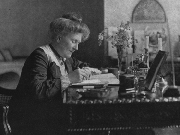 The opening Variation is of his wife Alice, who was possibly the person who most encouraged Elgar throughout his years of musical composition. Certainly she smoothed his path and enabled him to concentrate on his work. At the time of composition of the Enigma Variations she had had faith in him even though success and greatness for which he is now known was still around the corner.
The opening Variation is of his wife Alice, who was possibly the person who most encouraged Elgar throughout his years of musical composition. Certainly she smoothed his path and enabled him to concentrate on his work. At the time of composition of the Enigma Variations she had had faith in him even though success and greatness for which he is now known was still around the corner.
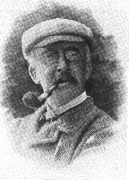 Hew Steuart-Powell was an early friend at a time when Elgar used to play in small orchestras and ensembles in the Worcester area. Steuart-Powell was a pianist and would 'warm-up' before a performance with a few finger-loosening exercises - a practice which is referred to in this Variation.
Hew Steuart-Powell was an early friend at a time when Elgar used to play in small orchestras and ensembles in the Worcester area. Steuart-Powell was a pianist and would 'warm-up' before a performance with a few finger-loosening exercises - a practice which is referred to in this Variation.
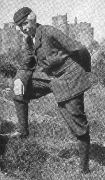 Baxter Townsend was an old friend of the Elgars with rather eccentric habits. He is described as having a brick-red weather-beaten face, bright blue eyes and a shock of grey hair. He was from Oxford where he used to ride around on a tricycle but, being slightly deaf, he had invented a device which was attached to his tricycle and which would continuously ring a bell to warn other road-users of his approach.
Baxter Townsend was an old friend of the Elgars with rather eccentric habits. He is described as having a brick-red weather-beaten face, bright blue eyes and a shock of grey hair. He was from Oxford where he used to ride around on a tricycle but, being slightly deaf, he had invented a device which was attached to his tricycle and which would continuously ring a bell to warn other road-users of his approach.
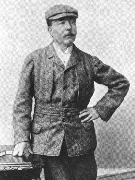 William Meath Baker - nicknamed 'The Squire' by the Elgars - was noted for being an excellent host with a penchant for arranging the timetable for the day. Characteristic - and the feature illustrated in his Variation - is his bustling manner and his way of slamming the door after he had left the room.
William Meath Baker - nicknamed 'The Squire' by the Elgars - was noted for being an excellent host with a penchant for arranging the timetable for the day. Characteristic - and the feature illustrated in his Variation - is his bustling manner and his way of slamming the door after he had left the room.
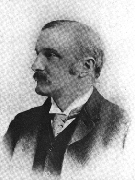 Richard Penrose Arnold has been described as 'literary, interesting, and amusing' - like Meath Baker, an excellent host, though altogether of a quieter disposition. He had a characteristic nervous laugh - 'HA-ha-ha, ha-ha-HA-ha-ha! - and this can be heard depicted in the woodwind.
Richard Penrose Arnold has been described as 'literary, interesting, and amusing' - like Meath Baker, an excellent host, though altogether of a quieter disposition. He had a characteristic nervous laugh - 'HA-ha-ha, ha-ha-HA-ha-ha! - and this can be heard depicted in the woodwind.
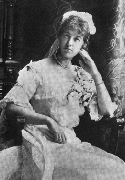 The Fittons were a well-known Worcestershire family who were very interested in the music of the area. Isabel was a keen viola player and had been having some coaching from Elgar. One of the difficult exercises for beginners is 'crossing the strings' and this Variation makes much play of this.
The Fittons were a well-known Worcestershire family who were very interested in the music of the area. Isabel was a keen viola player and had been having some coaching from Elgar. One of the difficult exercises for beginners is 'crossing the strings' and this Variation makes much play of this.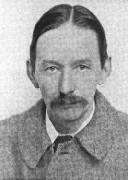 Troyte Griffith was a Malvern architect who tried - but failed - to play the piano. This was Elgar's explanation for the idea behind this Variation. Other interpreters have suggested that the Variation depicts a set of nine-pins (skittles) being knocked over as 'nine-pin' was Troyte's nickname owing to the outline of his silhouette. Troyte himself was of the opinion that the music relates to the time that he and Elgar were caught out in a thunderstorm and had to run for shelter.
Troyte Griffith was a Malvern architect who tried - but failed - to play the piano. This was Elgar's explanation for the idea behind this Variation. Other interpreters have suggested that the Variation depicts a set of nine-pins (skittles) being knocked over as 'nine-pin' was Troyte's nickname owing to the outline of his silhouette. Troyte himself was of the opinion that the music relates to the time that he and Elgar were caught out in a thunderstorm and had to run for shelter.
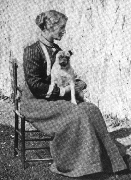 Winifred Norbury was a close neighbour of Elgar and, being an excellent pianist, would often help Elgar try out new musical ideas, she on the piano and he on the violin.
Winifred Norbury was a close neighbour of Elgar and, being an excellent pianist, would often help Elgar try out new musical ideas, she on the piano and he on the violin.
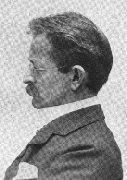 Jaeger was a great friend who's faith in Elgar often encouraged the composer to continue at times when he doubted his own talents. Jaeger was a music editor for the publisher, Novello, and his critical mind was invaluable to Elgar whilst sketching out his music. The name 'Nimrod', the mythical hunter, was chosen because 'Jaeger' is German for hunter.
Jaeger was a great friend who's faith in Elgar often encouraged the composer to continue at times when he doubted his own talents. Jaeger was a music editor for the publisher, Novello, and his critical mind was invaluable to Elgar whilst sketching out his music. The name 'Nimrod', the mythical hunter, was chosen because 'Jaeger' is German for hunter.
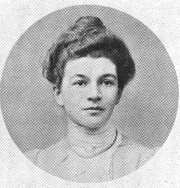 Dora Penny - nicknamed 'Dorabella' after the character from Mozart's Cosi fan Tutte was a long and close friend of Elgar's. Her memories of her friendship with Elgar are recalled in her book 'Edward Elgar, Memories of a Variation' which was published under her married name of Mrs. Richard Powell.
Dora Penny - nicknamed 'Dorabella' after the character from Mozart's Cosi fan Tutte was a long and close friend of Elgar's. Her memories of her friendship with Elgar are recalled in her book 'Edward Elgar, Memories of a Variation' which was published under her married name of Mrs. Richard Powell.
 Sinclair was organist at Hereford Cathedral and was owner of a bull dog, Dan. The photograph shows Sinclair (seated left) with Dan and Elgar (seated right). The episode depicted in the music is described below by Elgar. Also contained in the Variation is a passage which illustrates Sinclair's style of playing a pedal passage on the organ.
Sinclair was organist at Hereford Cathedral and was owner of a bull dog, Dan. The photograph shows Sinclair (seated left) with Dan and Elgar (seated right). The episode depicted in the music is described below by Elgar. Also contained in the Variation is a passage which illustrates Sinclair's style of playing a pedal passage on the organ.
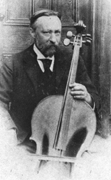 In Elgar's younger days, Nevinson was a cellist in the same trio as the pianist H.D. Steuart-Powell (Variation II) with Elgar as violinist. The Variation is written with a beautiful solo passage for the cello.
In Elgar's younger days, Nevinson was a cellist in the same trio as the pianist H.D. Steuart-Powell (Variation II) with Elgar as violinist. The Variation is written with a beautiful solo passage for the cello.
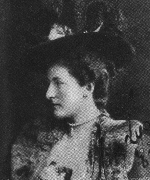 No name was ever publicly given to this Variation. Maybe the fact that it was the thirteenth made the more superstitious shy away from assigning too close a link? The name of Lady Mary Lygon has long been suggested and Elgar himself had supported that idea. But Lady Mary was not a close friend of the Elgars and the nature of the music certainly seems to suggest something more passionate than that of a casual acquaintance! More recently, the name of Helen Weaver has been suggested as a much more likely candidate. Helen Weaver was a former fianceé of Elgar's who broke the engagement (possibly in part due to a difference of religion) and who emigrated to New Zealand.
No name was ever publicly given to this Variation. Maybe the fact that it was the thirteenth made the more superstitious shy away from assigning too close a link? The name of Lady Mary Lygon has long been suggested and Elgar himself had supported that idea. But Lady Mary was not a close friend of the Elgars and the nature of the music certainly seems to suggest something more passionate than that of a casual acquaintance! More recently, the name of Helen Weaver has been suggested as a much more likely candidate. Helen Weaver was a former fianceé of Elgar's who broke the engagement (possibly in part due to a difference of religion) and who emigrated to New Zealand.
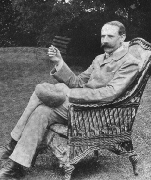 The heading 'E.D.U. refers to Alice's pet name for Elgar - 'Edoo". This finale rounds off the Variations and finishes the whole work with style.
The heading 'E.D.U. refers to Alice's pet name for Elgar - 'Edoo". This finale rounds off the Variations and finishes the whole work with style.
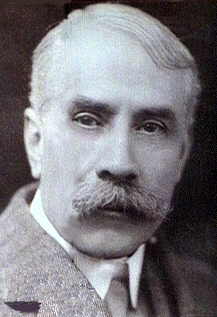 Return to the Main Menu
Return to the Main Menu